Abstract
The efficacy of a 5-day treatment with coumermycin A1 (hereafter referred to as coumermycin) (at three dosage regimens), with ciprofloxacin, or with coumermycin plus ciprofloxacin was tested in experimental aortic valve endocarditis induced in rats by a strain of methicillin-susceptible Staphylococcus aureus and was compared with the efficacy of a 5-day treatment with cloxacillin plus gentamicin. While coumermycin was far less effective than cloxacillin plus gentamicin in reducing the bacterial counts in vegetations (P less than 10(-8), ciprofloxacin was as effective as cloxacillin plus gentamicin. Coumermycin plus ciprofloxacin was less effective than ciprofloxacin alone (P = 0.01). For endocarditis induced by two additional methicillin-susceptible S. aureus strains, the high-dosage regimen of coumermycin (12 mg/kg every 12 h) had the same low efficacy. Coumermycin-resistant variants of S. aureus emerged in most of the vegetations during coumermycin treatment. The ciprofloxacin susceptibility of S. aureus was unchanged during ciprofloxacin treatment. The addition of ciprofloxacin to coumermycin in the treatment did not prevent the emergence of coumermycin-resistant variants. Twelve additional S. aureus strains isolated from the blood of patients with endocarditis were tested in vitro against coumermycin with precautions to avoid carry-over of the antibiotic. Coumermycin exhibited a bacteriostatic activity at very low concentrations (MIC, less than 0.004 microgram/ml) but only a weak bactericidal activity (MBC for 90% of strains, 8 micrograms/ml), a finding contrasting with that of others. Furthermore, coumermycin-resistant mutants could be selected in vitro from the 15 S. aureus strains tested. These results indicated no evidence in vivo of a synergistic activity of coumermycin and ciprofloxacin. More importantly, these results suggested that coumermycin might not be adequate for the treatment of serious s. aureus infections in humans.
Full text
PDF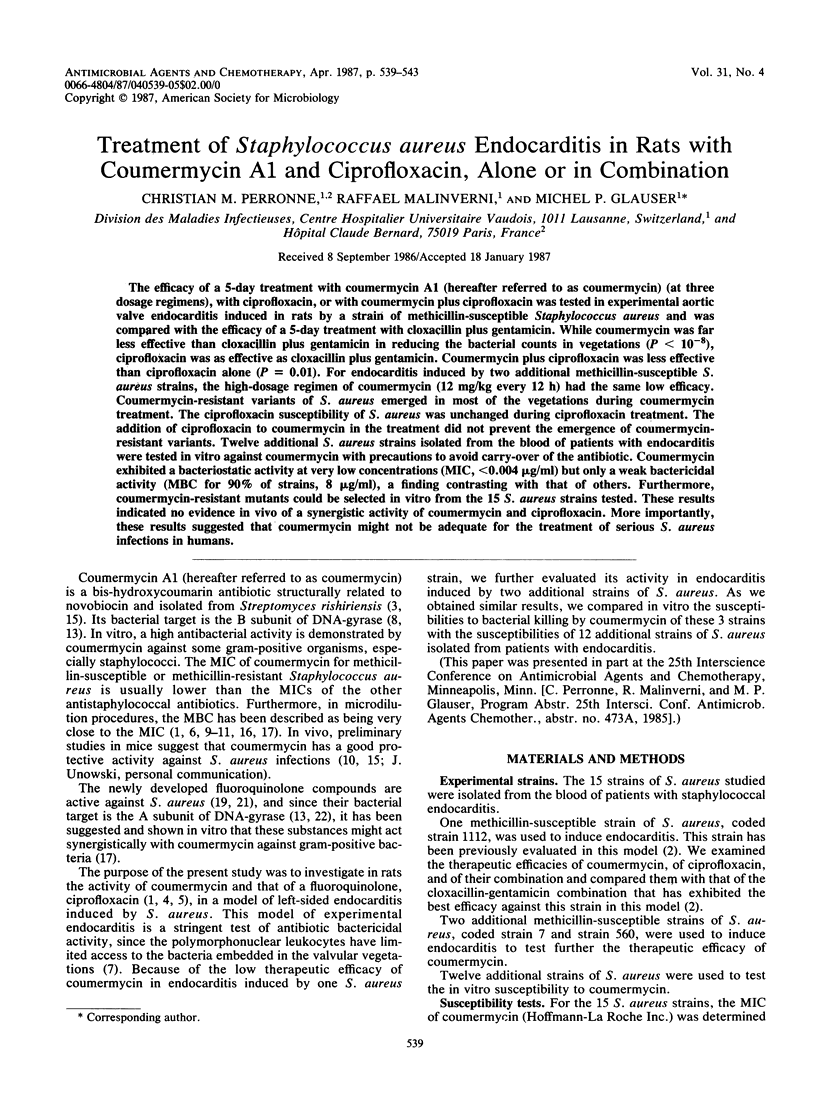
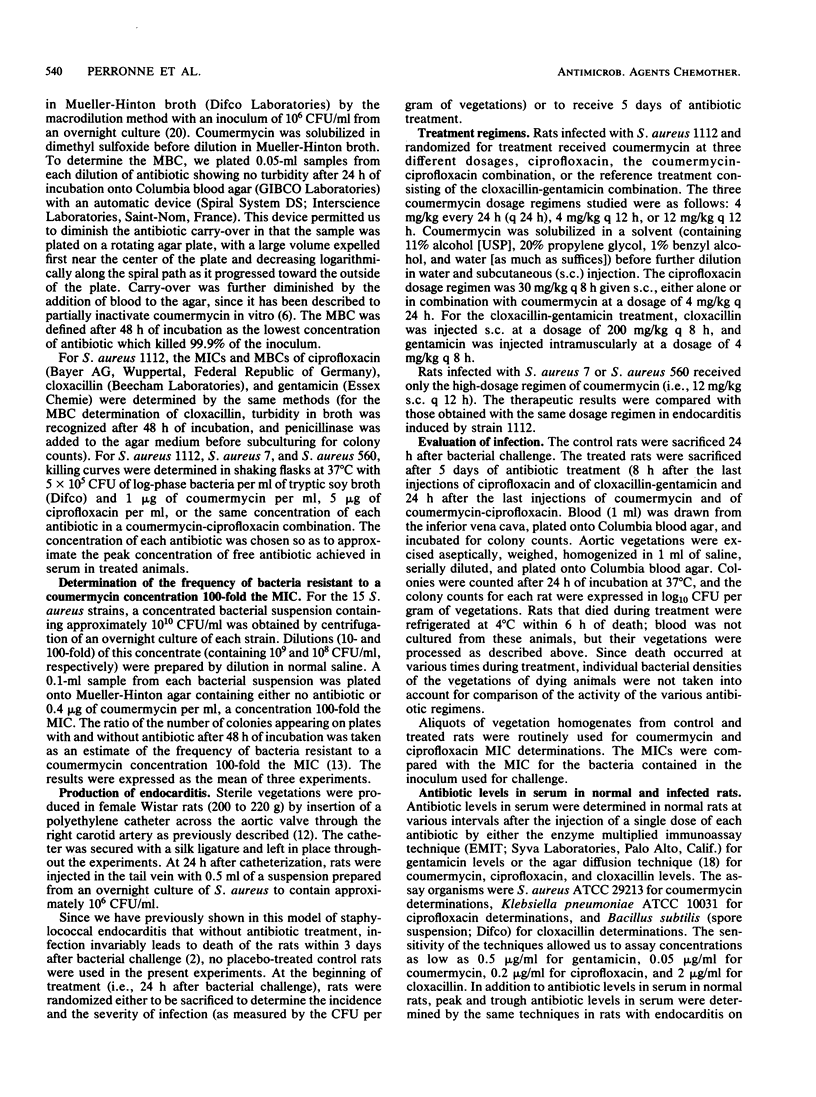
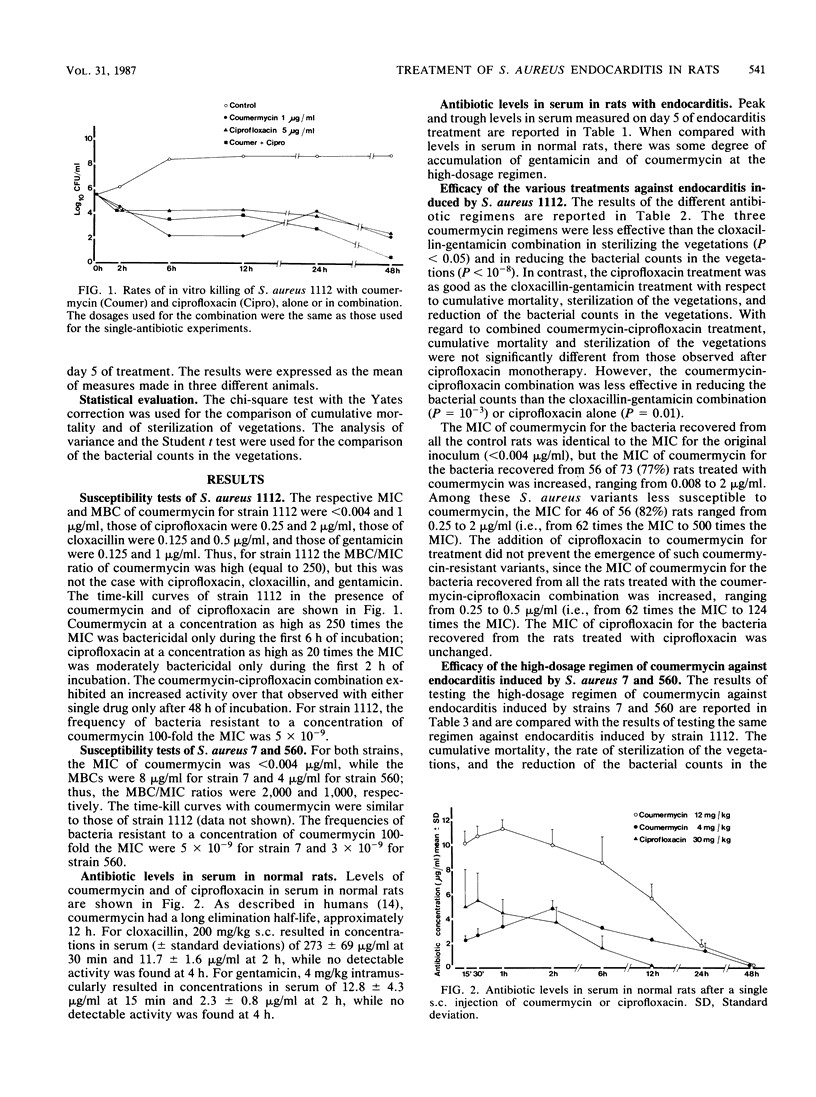
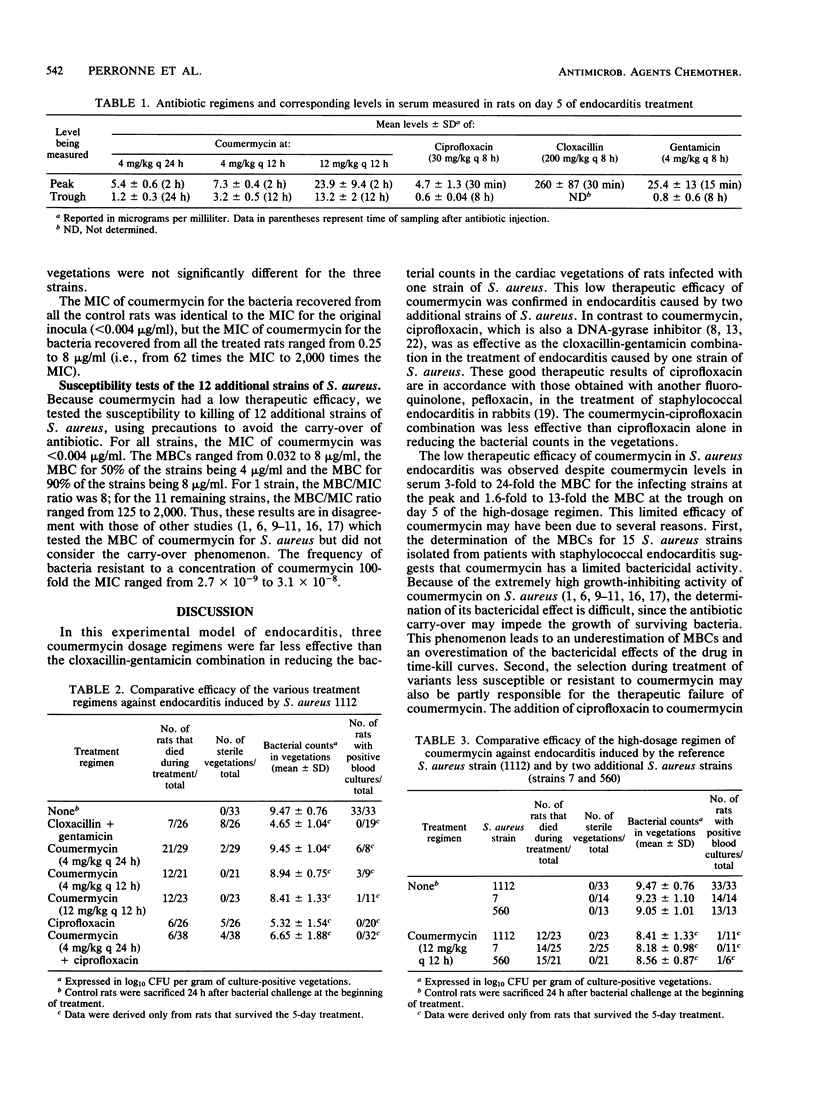
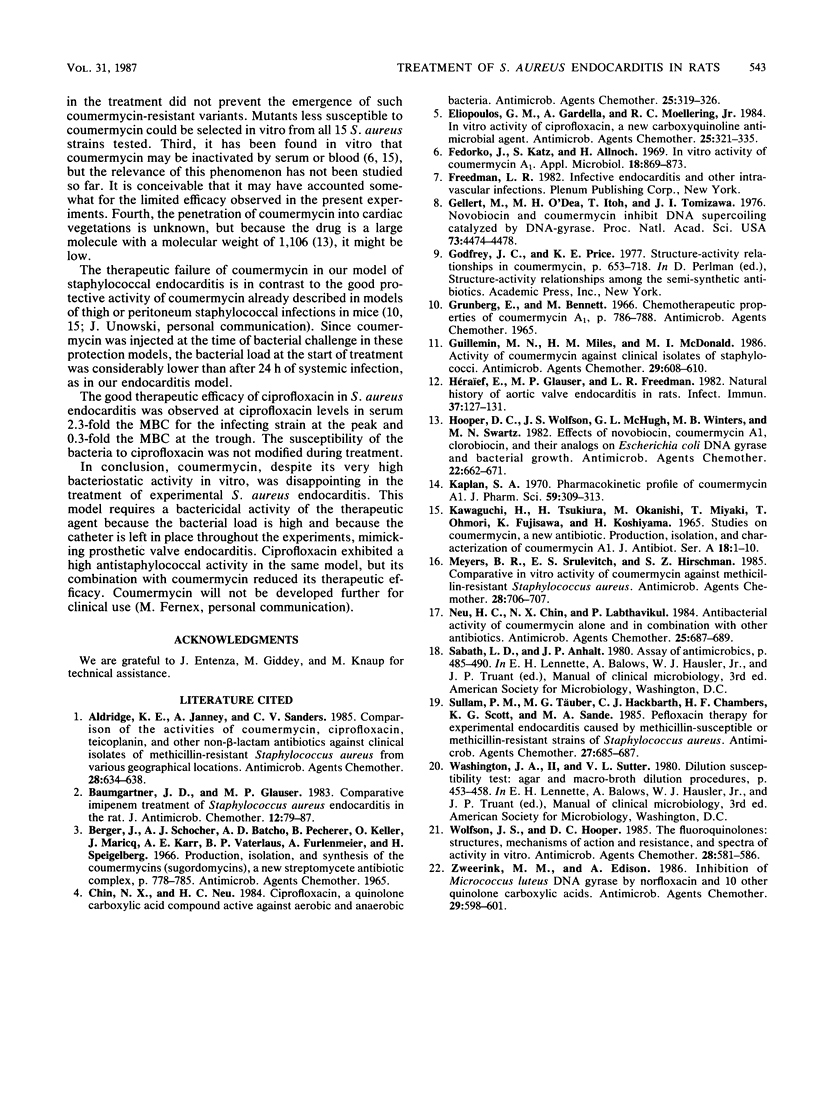
Selected References
These references are in PubMed. This may not be the complete list of references from this article.
- Aldridge K. E., Janney A., Sanders C. V. Comparison of the activities of coumermycin, ciprofloxacin, teicoplanin, and other non-beta-lactam antibiotics against clinical isolates of methicillin-resistant Staphylococcus aureus from various geographical locations. Antimicrob Agents Chemother. 1985 Nov;28(5):634–638. doi: 10.1128/aac.28.5.634. [DOI] [PMC free article] [PubMed] [Google Scholar]
- Baumgartner J. D., Glauser M. P. Comparative imipenem treatment of Staphylococcus aureus endocarditis in the rat. J Antimicrob Chemother. 1983 Dec;12 (Suppl 500):79–87. doi: 10.1093/jac/12.suppl_d.79. [DOI] [PubMed] [Google Scholar]
- Chin N. X., Neu H. C. Ciprofloxacin, a quinolone carboxylic acid compound active against aerobic and anaerobic bacteria. Antimicrob Agents Chemother. 1984 Mar;25(3):319–326. doi: 10.1128/aac.25.3.319. [DOI] [PMC free article] [PubMed] [Google Scholar]
- Eliopoulos G. M., Gardella A., Moellering R. C., Jr In vitro activity of ciprofloxacin, a new carboxyquinoline antimicrobial agent. Antimicrob Agents Chemother. 1984 Mar;25(3):331–335. doi: 10.1128/aac.25.3.331. [DOI] [PMC free article] [PubMed] [Google Scholar]
- Fedorko J., Katz S., Allnoch H. In vitro activity of coumermycin A1. Appl Microbiol. 1969 Nov;18(5):869–873. doi: 10.1128/am.18.5.869-873.1969. [DOI] [PMC free article] [PubMed] [Google Scholar]
- Gellert M., O'Dea M. H., Itoh T., Tomizawa J. Novobiocin and coumermycin inhibit DNA supercoiling catalyzed by DNA gyrase. Proc Natl Acad Sci U S A. 1976 Dec;73(12):4474–4478. doi: 10.1073/pnas.73.12.4474. [DOI] [PMC free article] [PubMed] [Google Scholar]
- Guillemin M. N., Miles H. M., McDonald M. I. Activity of coumermycin against clinical isolates of staphylococci. Antimicrob Agents Chemother. 1986 Apr;29(4):608–610. doi: 10.1128/aac.29.4.608. [DOI] [PMC free article] [PubMed] [Google Scholar]
- Hooper D. C., Wolfson J. S., McHugh G. L., Winters M. B., Swartz M. N. Effects of novobiocin, coumermycin A1, clorobiocin, and their analogs on Escherichia coli DNA gyrase and bacterial growth. Antimicrob Agents Chemother. 1982 Oct;22(4):662–671. doi: 10.1128/aac.22.4.662. [DOI] [PMC free article] [PubMed] [Google Scholar]
- Héraïef E., Glauser M. P., Freedman L. R. Natural history of aortic valve endocarditis in rats. Infect Immun. 1982 Jul;37(1):127–131. doi: 10.1128/iai.37.1.127-131.1982. [DOI] [PMC free article] [PubMed] [Google Scholar]
- KAWAGUCHI H., TSUKIURA H., OKANISHI M., MIYAKI T., OHMORI T., FUJISAWA K., KOSHIYAMA H. STUDIES ON COUMERMYCIN, A NEW ANTIBIOTIC. I. PRODUCTION, ISOLATION AND CHARACTERIZATION OF COUMERMYCIN A1. J Antibiot (Tokyo) 1965 Jan;18:1–10. [PubMed] [Google Scholar]
- Kaplan S. A. Pharmacokinetic profile of coumermycin A. J Pharm Sci. 1970 Mar;59(3):309–313. doi: 10.1002/jps.2600590306. [DOI] [PubMed] [Google Scholar]
- Meyers B. R., Srulevitch E. S., Hirschman S. Z. Comparative in vitro activity of coumermycin against methicillin-resistant Staphylococcus aureus. Antimicrob Agents Chemother. 1985 Nov;28(5):706–707. doi: 10.1128/aac.28.5.706. [DOI] [PMC free article] [PubMed] [Google Scholar]
- Neu H. C., Chin N. X., Labthavikul P. Antibacterial activity of coumermycin alone and in combination with other antibiotics. Antimicrob Agents Chemother. 1984 Jun;25(6):687–689. doi: 10.1128/aac.25.6.687. [DOI] [PMC free article] [PubMed] [Google Scholar]
- Sullam P. M., Täuber M. G., Hackbarth C. J., Chambers H. F., Scott K. G., Sande M. A. Pefloxacin therapy for experimental endocarditis caused by methicillin-susceptible or methicillin-resistant strains of Staphylococcus aureus. Antimicrob Agents Chemother. 1985 May;27(5):685–687. doi: 10.1128/aac.27.5.685. [DOI] [PMC free article] [PubMed] [Google Scholar]
- Wolfson J. S., Hooper D. C. The fluoroquinolones: structures, mechanisms of action and resistance, and spectra of activity in vitro. Antimicrob Agents Chemother. 1985 Oct;28(4):581–586. doi: 10.1128/aac.28.4.581. [DOI] [PMC free article] [PubMed] [Google Scholar]
- Zweerink M. M., Edison A. Inhibition of Micrococcus luteus DNA gyrase by norfloxacin and 10 other quinolone carboxylic acids. Antimicrob Agents Chemother. 1986 Apr;29(4):598–601. doi: 10.1128/aac.29.4.598. [DOI] [PMC free article] [PubMed] [Google Scholar]


